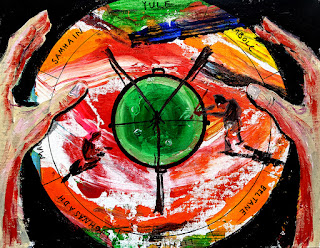Happy Walpurgisnacht, Beltane, and May Day!
 Saint Walburga, burner of witches luxuriating in the flames of the Asherah pole while the children dance for the great mother Goddess of the returning sun and somewhere in the distance the smell of bacon wafts from the sacrificial pregnant sow. Original painting and fine art prints available through Saatchi Art. Prints and merch also available in shop or through RedBubble or Fine Art America.
Saint Walburga, burner of witches luxuriating in the flames of the Asherah pole while the children dance for the great mother Goddess of the returning sun and somewhere in the distance the smell of bacon wafts from the sacrificial pregnant sow. Original painting and fine art prints available through Saatchi Art. Prints and merch also available in shop or through RedBubble or Fine Art America.Tonight marks a cross quarter day on the Celtic calendar. We are halfway between the spring equinox and the summer solstice. If Ceridwen was stirring her cauldron for the year, she would be 3/8 of the way through.
In ancient Greece, the beginning of May marks the return of Persephone from the underworld. The Romans named the month of May for the goddess Maia, to whom a pregnant sow would be sacrificed, in the tradition of Demeter and other Great Mother Goddesses. The name Maia is an honorific for older women related to Mater, or mother. (source)In Greece today, May Day can be celebrated by fire jumping, making of flower wreaths, or with Mayioxylo (the Greek version of the Maypole). In villages in Corfu, a decorated cypress log is carried in a procession while May songs are sung. (source)
"The Mayioxylo, representing fertility, is a branch from a fruit tree, usually pomegranate or almond, bearing tender young leaves, decorated with flowers, fruits and colourful ribbons and adorned with small phials of honey, sweet wine and olive oil, all of which symbolise fertility."
In addition to the Maypole, there are also May sticks. "If a young man happened to have been struck dead by the husband of a beautiful, but married young woman, who he had taken a fancy to, nudging him with a May stick was said to bring him back to life, illustrating the renewal and rebirth of the month of May.
"Any youthful man, touched by the May stick, was blessed with fertility and guaranteed many offspring.
"Much fun and bawdiness is to be had at Greek May Day celebrations, where women ‘pianoun to Mai’ – ‘grab May’, or are asked if they have ‘έπιασε το μαγιόξυλο?’- epiases to mayioxylo?- did you grab the May stick?" (source)
Flower wreaths made for May Day traditionally contain wild flowers. Additionally, "garlic and nettles are intertwined with the flowers to ward off evil, along with fruit, such as pomegranate, or figs, symbolising fertility."
Maypoles and bonfires can also be found on May 1 at Beltane in the British Isles. The name Beltane is said to come from the sun god, Bel or Belenus, but this is a relatively recent phenomenon. Traditionally, the Celtic sun was a woman - Brigid, Aine, Grainne, Sunna, Etain, and/or Nantosuelta.
The Mid Atlantic Geomancy blog makes the following connections, "Beltane means "the fires of Bel." This Sun God Bel supplanted Bride in the British (hear her name again?) Isles. He was part of the patriarchal takeover of Europe. In Ireland, Bil, the God of the underworld, is the father of Miled. The sons of Mil (read: Miled), or the Milesians, were the Goidelic Celts who took over Ireland from the Partholanians. They came from Spain, the Gaelic land of the dead. Bel is found all over mainland Europe. Belgium. Caesar, who first met him in Gaul called him "Belenos," and saw him as comparable to Apollo (the Sun again). Down in what is now Lebanon, in the "Old Testament," we frequently hear of the Hebrew women leaving their homes to be with the Canaanite Goddess Asherah or Astarte and her lover consort Baal. (Incidentally, the Anglo Saxons called Astarte "Ostara" – the Goddess of the East. It's where we get the name "Easter" from. Real Christian derivation isn't it?)
So, Beltane = a festival of the Goddess, with a thin veneer of patriarchy. That makes sense to me. Asherah poles = May poles. Insert heart emojis here.
And....I also said Happy Walpurgisnacht. Here, we go one step farther into vilification of the Goddess. May Day / Beltane becomes the time to purge the world of witches. St Walpurga is known for ridding Germany of witches. The night of April 30 / morning of May 1 becomes Walpurgisnacht in her honor. Great. Luckily, the patriarchy is failing. Happy Walpurgisnacht Beltane May Day, witches.

Comments
Post a Comment